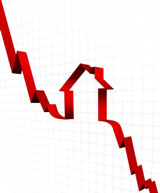Mortgage managers, banks, credit unions, brokers, insurance groups all offer a seemingly endless choice of loan options – introductory rates, standard variable rates, fixed rates, redraw facilities, lines of credit loans and interest only loans, the list goes on. But with choice comes confusion. How do you determine what the best type of home loan is for you?
First, set your financial goals, determine your budget and work out how long you want to pay a mortgage for. You can do this yourself or with your financial advisor or accountant.
Second, ensure the organization or person you choose to obtain your mortgage from is a member of the Mortgage Finance Association of Australia (MFAA). The MFAA Member logo ensures you are working with a professional who is bound by a strict industry code of practice.
Third, research the types of loans available so you can explore all options available to you with your mortgage provider. Some home loan choices are:
Basic Home Loan
This loan is considered a no-frills loan and usually offers a very low variable interest rate with little or no regular fees. Be aware they usually don’t offer additional extras or flexibility in paying of extra on the loan or varying your repayments.
These loans are suited to people who don’t foresee a dramatic change in personal circumstances and thus will not need to adapt the loan in accordance with any lifestyle changes, or people who are happy to pay a set amount each month for the duration of the loan.
Introductory Rate or ‘Honeymoon’ Loan
This loan is attractive as it offers lower interest rates than the standard fixed or variable rates for the initial (honeymoon) period of the loan (i.e. six to 12 months)
before rolling over to the standard rates. The length of the honeymoon depends on the lender, as too does the rate you pay once the honeymoon is over. This loan usually allows flexibility by allowing you to pay extra off the loan. Be aware of any caps on additional repayments in the initial period, of any exit fees at any time of the loan (usually high if you change immediately after the honeymoon), and what your repayments will be after the loan rolls over to the standard interest rate.
These loans are suited to people who want to minimise their initial repayments (whilst perhaps doing renovations) or to those who wish to make a large dent in their loan through extra repayments while benefiting from the lower rate of interest.
Tip: If you start paying off this loan at the post-honeymoon rate, you are paying off extra and will not have to make a lifestyle change when the introductory offer has finished.
Redraw Facility
This loan allows you to put additional funds into the loan in order to bring down the principal amount and reduce interest charges, plus it gives the option to redraw the additional funds you put in at any time. Simply put, rather than earning (taxable) interest from your savings, putting your savings into the loan saves you money on your interest charges and helps you pay off your loan faster. Meanwhile, you are still saving for the future. The benefit of this type of loan is the interest charged is normally cheaper than the standard variable rate and it doesn’t incur regular fees. Be aware there may be an activation fee to obtain a redraw facility, there may be a fee for each time you redraw, and it may have a minimum redraw amount.
These loans are suited to low to medium income earners who can put away that little extra each month.
Line of Credit/Equity Line
This is a pre-approved limit of money you can borrow either in its entirety or in bits at a time. The popularity of these loans is due to its flexibility and ability to reduce mortgages quickly. However, they usually require the borrower to offer their house as security for the loan. A line of credit can be set to a negotiated time (normally 1-5 years) or be classed as revolving (longer terms) and you only have to pay interest on the money you use (or ‘draw down’). Interest rates are variable and due to the level of flexibility are often higher than the standard variable rate. Some lines of credit will allow you to capitalise the interest until you reach your credit limit i.e. use your line of credit to pay off the interest on your line of credit. Most of these loans have a monthly, half yearly or annual fee attached.
These loans are suited to people who are financially responsible and already have property and wish to use their property or equity in their property for renovations, investments or personal use.
All In One Accounts
This is a loan which works as an account where all income is deposited in the account and all expenses come out of the account. The benefit of the All In One Account is its ability to reduce the amount owed and thus the interest payments while providing a one-stop finance shop where your loan, cheque, credit and savings accounts are combined into one. Normally these loans will be at the standard variable rate or slightly higher and may incur monthly fees. Be aware that if the account is split into the loan account, with credit, cheque and ATM facilities placed into satellite accounts, you will need to check your access to funds, how many free transactions you receive, and what associated fees the loan may have.
These loans are suited to medium to high income earners.
100% Offset Account
This loan is similar to an All In One Account however the money is paid into an account which is linked to the loan – this account is called an Offset Account. Income is deposited into the Offset Account and you use the Offset Account for all your EFTPOS, cheque, internet banking, credit transactions. Whatever is in the Offset Account then comes directly off the loan, or ‘offsets’ the loan amount for interest. Effectively you are not earning interest on your savings, but are benefiting as what would be interest on savings is calculated on a reduction on your loan. The advantages are similar to the All In One Account. These loans normally have a higher interest rate and higher fees due to their flexibility.
These loans are suited to people on medium to high income earners, and to disciplined spenders as the more money kept in the offset account the faster you pay-off your loan.
Partial offset account and an interest offset account are also available.
Split Loans
This is a loan where the overall money borrowed is split into different segments where each segment has a different loan structure i.e. part fixed, part varied and part line of credit. Often called designer loans, you benefit from one or more types of loans. Splitting the loan offers a saving on stamp duty and other charges.
These loans are suited to people who want minimize risk and hedge their bets against interest rate changes while maintaining a good degree of flexibility.
Professional Package
This loan is available at a minimum amount to people on higher incomes or people of a specific profession if they meet certain requirements. The benefit of this loan is being able to borrow higher amounts with a high degree of flexibility and a discount on the standard variable interest rate. The level of discount is dependent on the size of the loan, and the duration of the discount depends on what’s negotiated and can sometimes apply for the life of the loan. Generally these products combine all fees into the one annual fee. Lenders of this product usually provide a lot of added values such as credit cards, discounts on their insurance and investment products.
Tip: If you don’t need the additional extras other loan types may offer a better interest rate.
Non Conforming Loan
These loans are only available from non-bank lenders where interest rates are higher due to the greater risk and shorter life of the loan. The advantage is they are available to people who don’t fill the traditional lending institution criteria. There are two types of Non Confirming loans:
- A Low Doc Loan usually has a slightly higher interest rate and fees than the standard interest rate and will have a maximum borrowing amount and/or will usually only lend 70% of the value of the property. After demonstrating the ability to meet the payments the interest rate will often revert to the standard rate.
These loans are suited to people who do not wish to disclose their income or have the inability to show a true income i.e. if you are self employed.
- Sub-Prime Loans usually have a much higher interest rate and fees than the standard rate and usually require you to use an asset as security. They are based on a sliding scale in accordance to the level of risk of loaning the money. Refinancing is available once the borrower can establish a good payment record.
These loans are suited to people with poor credit histories.
Other Loans and Products in the Market Include:
Construction Loans: For those building a home when you don’t need the entire amount from the start – you only pay interest on what you’ve spent over the stages of construction.
Bridging Loans: For when the sale of an existing property takes place after the settlement of a new property – when you want to buy a new home before selling the old one, where the funds from selling the old home are paid straight into the loan for the new home.
Consolidation Loans: Enables you to use your mortgage to consolidate other debts such as credit cards, personal loans, car loans etc. – interest rates on the mortgage are usually cheaper than personal loans.
 An interest in advance loan enables you to pre-pay the interest of the loan for the following financial year. These are available from a number of different lenders with fixed rates for a period of up to 5 years.
An interest in advance loan enables you to pre-pay the interest of the loan for the following financial year. These are available from a number of different lenders with fixed rates for a period of up to 5 years.

 “Capped”, it usually means that there is a limit or there is a certain boundary that cannot be crossed. A capped loan similarly would mean that the interest rates have a limit set to them, and cannot go above a certain point. This is of course limited to a certain period, which may be a number of years.
“Capped”, it usually means that there is a limit or there is a certain boundary that cannot be crossed. A capped loan similarly would mean that the interest rates have a limit set to them, and cannot go above a certain point. This is of course limited to a certain period, which may be a number of years. To fix or not to fix your loan is a common question. Another common question is for how long you should fix your loan rate. This can last from a few years to several years. Deciding on whether or not to fix is also essential as this can have great impact on the interest rate you will be paying and your total expenses.
To fix or not to fix your loan is a common question. Another common question is for how long you should fix your loan rate. This can last from a few years to several years. Deciding on whether or not to fix is also essential as this can have great impact on the interest rate you will be paying and your total expenses. Australia’s Reserve Bank, like so many around the world, has been cutting interest rates for months and in December 2008, the country’s official interest rate was reduced to its lowest level since May 2002.
Australia’s Reserve Bank, like so many around the world, has been cutting interest rates for months and in December 2008, the country’s official interest rate was reduced to its lowest level since May 2002.